Compliance Management for Charity Care
VerifiedAdded on 2023/01/23
|17
|3767
|21
AI Summary
This document provides an overview of compliance management for Charity Care, a not-for-profit organization in Australia. It covers compliance requirements, internal and external compliance, industry compliance, compliance effects, compliance management systems, personnel requirements, training options, and processes for managing compliance breaches.
Contribute Materials
Your contribution can guide someone’s learning journey. Share your
documents today.

Running head: COMPLIANCE MANAGEMENT
Compliance Management
Name of the Student:
Name of the University:
Author Note:
Compliance Management
Name of the Student:
Name of the University:
Author Note:
Secure Best Marks with AI Grader
Need help grading? Try our AI Grader for instant feedback on your assignments.
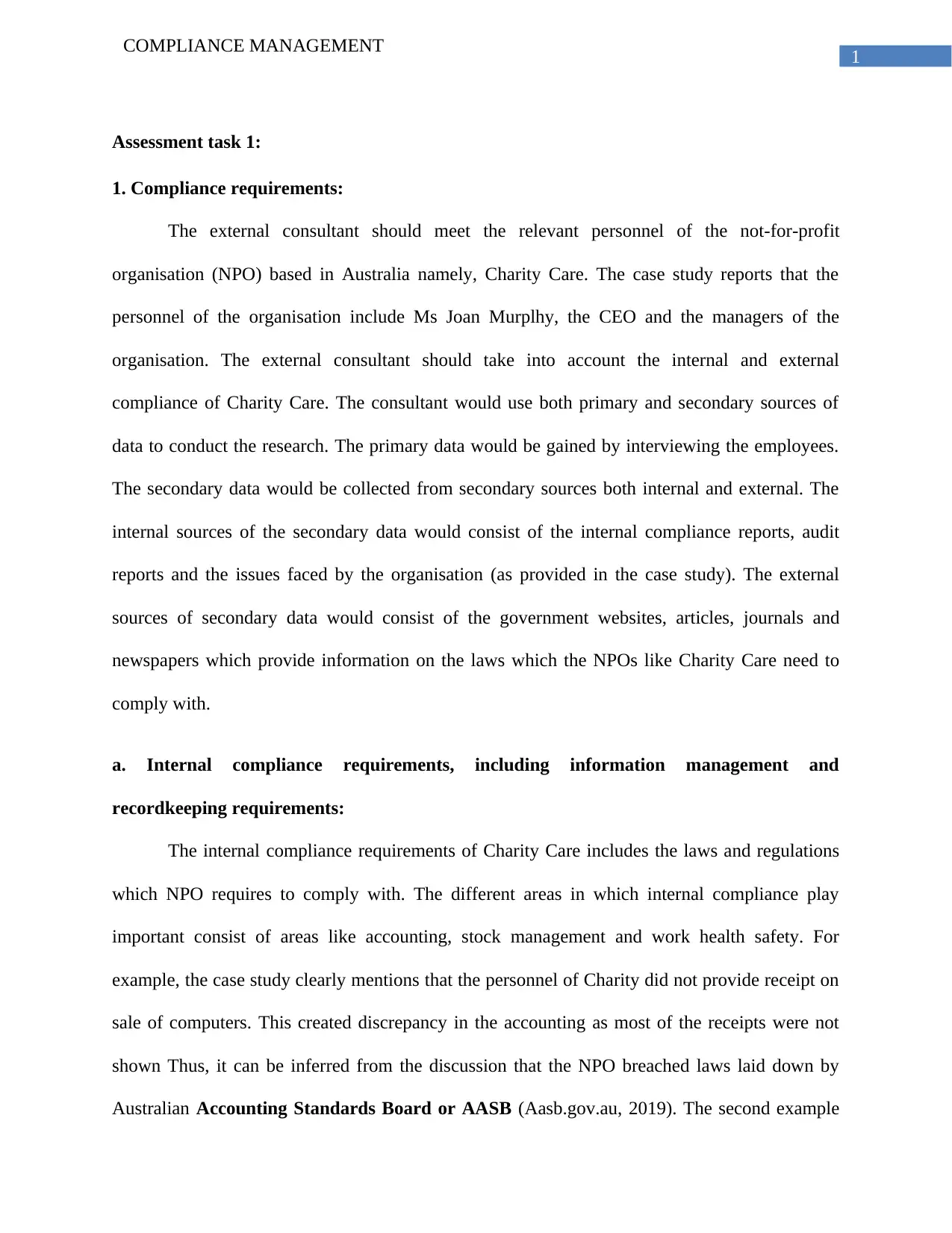
1
COMPLIANCE MANAGEMENT
Assessment task 1:
1. Compliance requirements:
The external consultant should meet the relevant personnel of the not-for-profit
organisation (NPO) based in Australia namely, Charity Care. The case study reports that the
personnel of the organisation include Ms Joan Murplhy, the CEO and the managers of the
organisation. The external consultant should take into account the internal and external
compliance of Charity Care. The consultant would use both primary and secondary sources of
data to conduct the research. The primary data would be gained by interviewing the employees.
The secondary data would be collected from secondary sources both internal and external. The
internal sources of the secondary data would consist of the internal compliance reports, audit
reports and the issues faced by the organisation (as provided in the case study). The external
sources of secondary data would consist of the government websites, articles, journals and
newspapers which provide information on the laws which the NPOs like Charity Care need to
comply with.
a. Internal compliance requirements, including information management and
recordkeeping requirements:
The internal compliance requirements of Charity Care includes the laws and regulations
which NPO requires to comply with. The different areas in which internal compliance play
important consist of areas like accounting, stock management and work health safety. For
example, the case study clearly mentions that the personnel of Charity did not provide receipt on
sale of computers. This created discrepancy in the accounting as most of the receipts were not
shown Thus, it can be inferred from the discussion that the NPO breached laws laid down by
Australian Accounting Standards Board or AASB (Aasb.gov.au, 2019). The second example
COMPLIANCE MANAGEMENT
Assessment task 1:
1. Compliance requirements:
The external consultant should meet the relevant personnel of the not-for-profit
organisation (NPO) based in Australia namely, Charity Care. The case study reports that the
personnel of the organisation include Ms Joan Murplhy, the CEO and the managers of the
organisation. The external consultant should take into account the internal and external
compliance of Charity Care. The consultant would use both primary and secondary sources of
data to conduct the research. The primary data would be gained by interviewing the employees.
The secondary data would be collected from secondary sources both internal and external. The
internal sources of the secondary data would consist of the internal compliance reports, audit
reports and the issues faced by the organisation (as provided in the case study). The external
sources of secondary data would consist of the government websites, articles, journals and
newspapers which provide information on the laws which the NPOs like Charity Care need to
comply with.
a. Internal compliance requirements, including information management and
recordkeeping requirements:
The internal compliance requirements of Charity Care includes the laws and regulations
which NPO requires to comply with. The different areas in which internal compliance play
important consist of areas like accounting, stock management and work health safety. For
example, the case study clearly mentions that the personnel of Charity did not provide receipt on
sale of computers. This created discrepancy in the accounting as most of the receipts were not
shown Thus, it can be inferred from the discussion that the NPO breached laws laid down by
Australian Accounting Standards Board or AASB (Aasb.gov.au, 2019). The second example
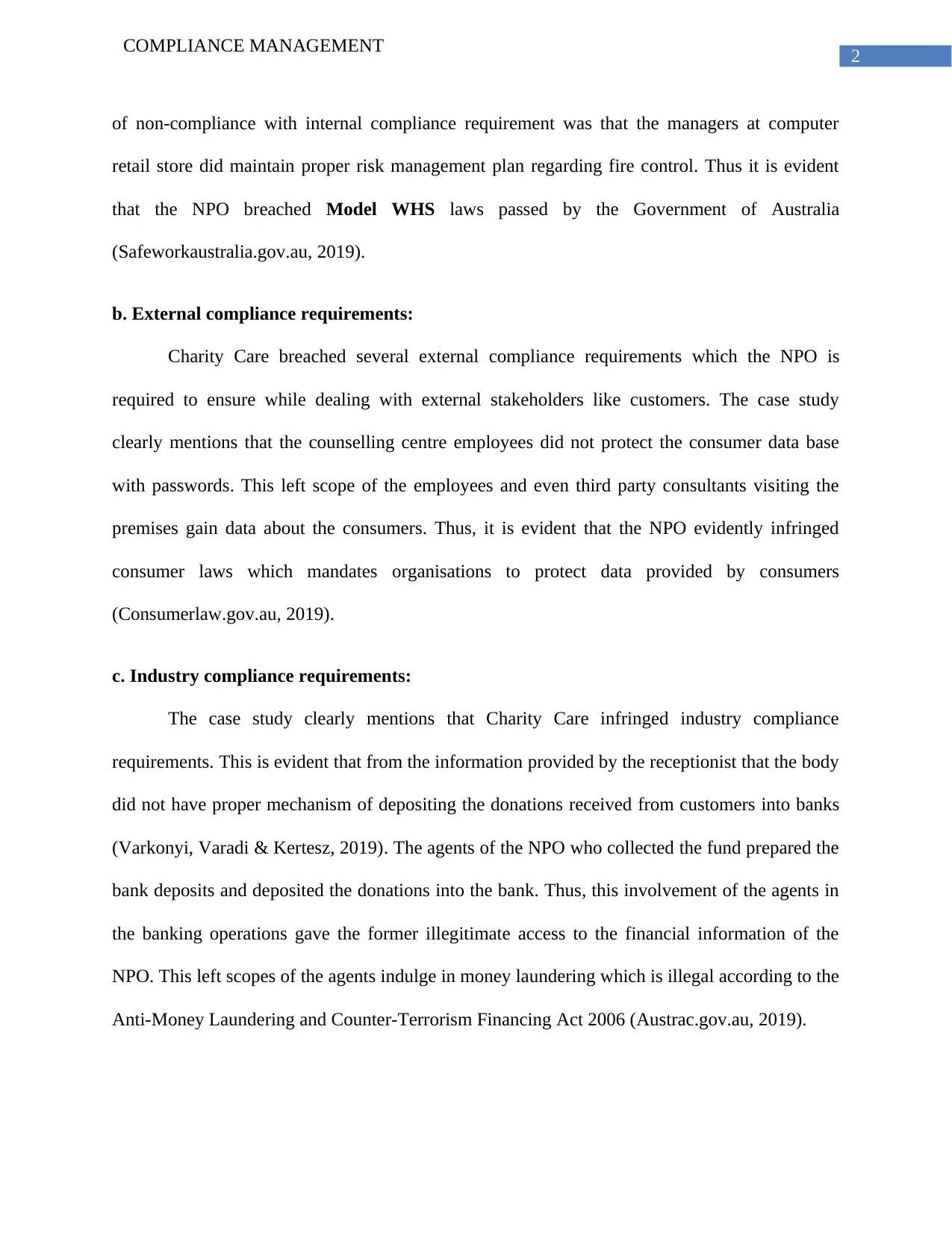
2
COMPLIANCE MANAGEMENT
of non-compliance with internal compliance requirement was that the managers at computer
retail store did maintain proper risk management plan regarding fire control. Thus it is evident
that the NPO breached Model WHS laws passed by the Government of Australia
(Safeworkaustralia.gov.au, 2019).
b. External compliance requirements:
Charity Care breached several external compliance requirements which the NPO is
required to ensure while dealing with external stakeholders like customers. The case study
clearly mentions that the counselling centre employees did not protect the consumer data base
with passwords. This left scope of the employees and even third party consultants visiting the
premises gain data about the consumers. Thus, it is evident that the NPO evidently infringed
consumer laws which mandates organisations to protect data provided by consumers
(Consumerlaw.gov.au, 2019).
c. Industry compliance requirements:
The case study clearly mentions that Charity Care infringed industry compliance
requirements. This is evident that from the information provided by the receptionist that the body
did not have proper mechanism of depositing the donations received from customers into banks
(Varkonyi, Varadi & Kertesz, 2019). The agents of the NPO who collected the fund prepared the
bank deposits and deposited the donations into the bank. Thus, this involvement of the agents in
the banking operations gave the former illegitimate access to the financial information of the
NPO. This left scopes of the agents indulge in money laundering which is illegal according to the
Anti-Money Laundering and Counter-Terrorism Financing Act 2006 (Austrac.gov.au, 2019).
COMPLIANCE MANAGEMENT
of non-compliance with internal compliance requirement was that the managers at computer
retail store did maintain proper risk management plan regarding fire control. Thus it is evident
that the NPO breached Model WHS laws passed by the Government of Australia
(Safeworkaustralia.gov.au, 2019).
b. External compliance requirements:
Charity Care breached several external compliance requirements which the NPO is
required to ensure while dealing with external stakeholders like customers. The case study
clearly mentions that the counselling centre employees did not protect the consumer data base
with passwords. This left scope of the employees and even third party consultants visiting the
premises gain data about the consumers. Thus, it is evident that the NPO evidently infringed
consumer laws which mandates organisations to protect data provided by consumers
(Consumerlaw.gov.au, 2019).
c. Industry compliance requirements:
The case study clearly mentions that Charity Care infringed industry compliance
requirements. This is evident that from the information provided by the receptionist that the body
did not have proper mechanism of depositing the donations received from customers into banks
(Varkonyi, Varadi & Kertesz, 2019). The agents of the NPO who collected the fund prepared the
bank deposits and deposited the donations into the bank. Thus, this involvement of the agents in
the banking operations gave the former illegitimate access to the financial information of the
NPO. This left scopes of the agents indulge in money laundering which is illegal according to the
Anti-Money Laundering and Counter-Terrorism Financing Act 2006 (Austrac.gov.au, 2019).
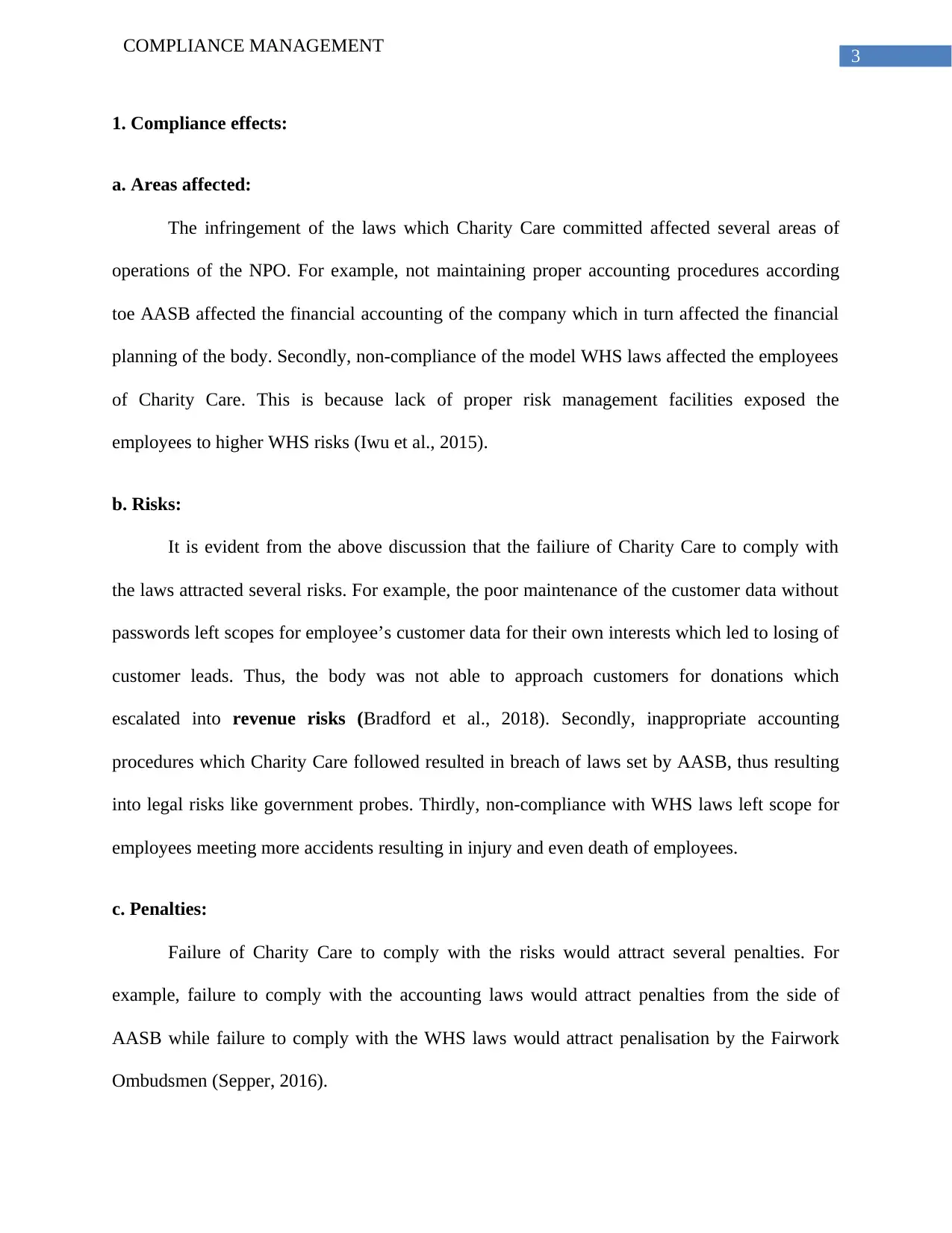
3
COMPLIANCE MANAGEMENT
1. Compliance effects:
a. Areas affected:
The infringement of the laws which Charity Care committed affected several areas of
operations of the NPO. For example, not maintaining proper accounting procedures according
toe AASB affected the financial accounting of the company which in turn affected the financial
planning of the body. Secondly, non-compliance of the model WHS laws affected the employees
of Charity Care. This is because lack of proper risk management facilities exposed the
employees to higher WHS risks (Iwu et al., 2015).
b. Risks:
It is evident from the above discussion that the failiure of Charity Care to comply with
the laws attracted several risks. For example, the poor maintenance of the customer data without
passwords left scopes for employee’s customer data for their own interests which led to losing of
customer leads. Thus, the body was not able to approach customers for donations which
escalated into revenue risks (Bradford et al., 2018). Secondly, inappropriate accounting
procedures which Charity Care followed resulted in breach of laws set by AASB, thus resulting
into legal risks like government probes. Thirdly, non-compliance with WHS laws left scope for
employees meeting more accidents resulting in injury and even death of employees.
c. Penalties:
Failure of Charity Care to comply with the risks would attract several penalties. For
example, failure to comply with the accounting laws would attract penalties from the side of
AASB while failure to comply with the WHS laws would attract penalisation by the Fairwork
Ombudsmen (Sepper, 2016).
COMPLIANCE MANAGEMENT
1. Compliance effects:
a. Areas affected:
The infringement of the laws which Charity Care committed affected several areas of
operations of the NPO. For example, not maintaining proper accounting procedures according
toe AASB affected the financial accounting of the company which in turn affected the financial
planning of the body. Secondly, non-compliance of the model WHS laws affected the employees
of Charity Care. This is because lack of proper risk management facilities exposed the
employees to higher WHS risks (Iwu et al., 2015).
b. Risks:
It is evident from the above discussion that the failiure of Charity Care to comply with
the laws attracted several risks. For example, the poor maintenance of the customer data without
passwords left scopes for employee’s customer data for their own interests which led to losing of
customer leads. Thus, the body was not able to approach customers for donations which
escalated into revenue risks (Bradford et al., 2018). Secondly, inappropriate accounting
procedures which Charity Care followed resulted in breach of laws set by AASB, thus resulting
into legal risks like government probes. Thirdly, non-compliance with WHS laws left scope for
employees meeting more accidents resulting in injury and even death of employees.
c. Penalties:
Failure of Charity Care to comply with the risks would attract several penalties. For
example, failure to comply with the accounting laws would attract penalties from the side of
AASB while failure to comply with the WHS laws would attract penalisation by the Fairwork
Ombudsmen (Sepper, 2016).
Secure Best Marks with AI Grader
Need help grading? Try our AI Grader for instant feedback on your assignments.

4
COMPLIANCE MANAGEMENT
d. Risk minimisation.
Charity Care should should form risk management plan of RMP to minimise the risks
pertaining to breach of laws.
3. Compliance Systems:
The compliance system which the management of Charity Care should implement should
operate under the supervision of the senior managers and the managers of the different branch
offices of the body. The management of Charity Care should form policies which would
underline the methods in which all the departments should comply with the laws. The
compliance system should apply to all the employees of the organisations. The management
should also lay down the steps which would be taken to deal with non-compliance of laws by
particular employees (Sitdikova et al., 2015).
a. Available systems, options or components, including discussion of relevant standards for
each option; for example risk management and implementation of a risk management
system:
The management of Charity Care should consider the available systems, options and
components which can be incorporated to ensure legal compliance within the body. For example,
as per Murray (2017)the management should hold meetings with the stakeholders like the senior
management officials, employees and the stakeholders. This would lead to recognising the risks
which infringement of the laws would attract towards the charity firm. This would lead to
formation of RMP and its successful implementation.
COMPLIANCE MANAGEMENT
d. Risk minimisation.
Charity Care should should form risk management plan of RMP to minimise the risks
pertaining to breach of laws.
3. Compliance Systems:
The compliance system which the management of Charity Care should implement should
operate under the supervision of the senior managers and the managers of the different branch
offices of the body. The management of Charity Care should form policies which would
underline the methods in which all the departments should comply with the laws. The
compliance system should apply to all the employees of the organisations. The management
should also lay down the steps which would be taken to deal with non-compliance of laws by
particular employees (Sitdikova et al., 2015).
a. Available systems, options or components, including discussion of relevant standards for
each option; for example risk management and implementation of a risk management
system:
The management of Charity Care should consider the available systems, options and
components which can be incorporated to ensure legal compliance within the body. For example,
as per Murray (2017)the management should hold meetings with the stakeholders like the senior
management officials, employees and the stakeholders. This would lead to recognising the risks
which infringement of the laws would attract towards the charity firm. This would lead to
formation of RMP and its successful implementation.

5
COMPLIANCE MANAGEMENT
b. Comparing systems or components in terms of:
i. Cost:
The management should compare the costs which Charity Care would incur in order to
implement a concrete legal compliance procedure. For example, According to Pamacheche,
Chinomona and Chuchu (2016), the management has to take into account the cost of training
employees of different departments and installing online fund transfer to banks.
ii. Effectiveness:
According to Winand et al. (2016), the management should take into account the
effectiveness within the internal operations which legal compliance would usher. This means that
management should consider the benefits which compliance with laws would usher in terms of
stakeholder management as well. For example, the management consider benefits like lowering
legal costs stemming from litigations and more support from the government.
iii. Efficiency:
The management should measure the efficiency which legal compliance with attribute the
body. For example, implementation of WHS laws and installation of proper risk management
machines like fire extinguishers would enable better control of fire (Safeworkaustralia.gov.au,
2019). The body by providing training to employees on risk management would be able to
reduce the rates of injuries which would boost productivity. In fact increase in WHS would
motivate the employees, this boosting productivity.
iv. Feasibility:
The management of Charity Care should measure the feasibility of total legal
compliance. This is because, total legal compliance is not feasible at Charity Care at least, in the
COMPLIANCE MANAGEMENT
b. Comparing systems or components in terms of:
i. Cost:
The management should compare the costs which Charity Care would incur in order to
implement a concrete legal compliance procedure. For example, According to Pamacheche,
Chinomona and Chuchu (2016), the management has to take into account the cost of training
employees of different departments and installing online fund transfer to banks.
ii. Effectiveness:
According to Winand et al. (2016), the management should take into account the
effectiveness within the internal operations which legal compliance would usher. This means that
management should consider the benefits which compliance with laws would usher in terms of
stakeholder management as well. For example, the management consider benefits like lowering
legal costs stemming from litigations and more support from the government.
iii. Efficiency:
The management should measure the efficiency which legal compliance with attribute the
body. For example, implementation of WHS laws and installation of proper risk management
machines like fire extinguishers would enable better control of fire (Safeworkaustralia.gov.au,
2019). The body by providing training to employees on risk management would be able to
reduce the rates of injuries which would boost productivity. In fact increase in WHS would
motivate the employees, this boosting productivity.
iv. Feasibility:
The management of Charity Care should measure the feasibility of total legal
compliance. This is because, total legal compliance is not feasible at Charity Care at least, in the
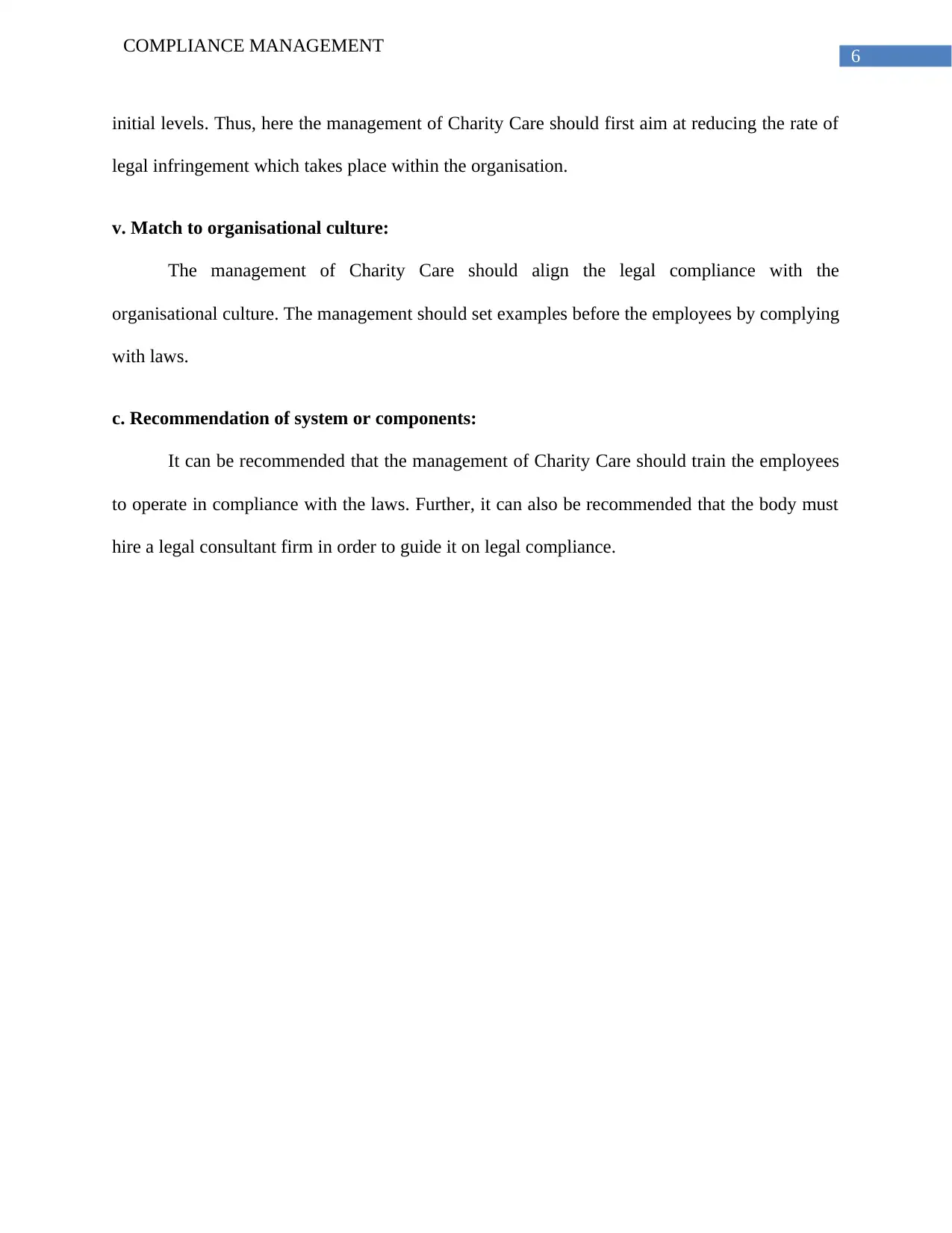
6
COMPLIANCE MANAGEMENT
initial levels. Thus, here the management of Charity Care should first aim at reducing the rate of
legal infringement which takes place within the organisation.
v. Match to organisational culture:
The management of Charity Care should align the legal compliance with the
organisational culture. The management should set examples before the employees by complying
with laws.
c. Recommendation of system or components:
It can be recommended that the management of Charity Care should train the employees
to operate in compliance with the laws. Further, it can also be recommended that the body must
hire a legal consultant firm in order to guide it on legal compliance.
COMPLIANCE MANAGEMENT
initial levels. Thus, here the management of Charity Care should first aim at reducing the rate of
legal infringement which takes place within the organisation.
v. Match to organisational culture:
The management of Charity Care should align the legal compliance with the
organisational culture. The management should set examples before the employees by complying
with laws.
c. Recommendation of system or components:
It can be recommended that the management of Charity Care should train the employees
to operate in compliance with the laws. Further, it can also be recommended that the body must
hire a legal consultant firm in order to guide it on legal compliance.
Paraphrase This Document
Need a fresh take? Get an instant paraphrase of this document with our AI Paraphraser
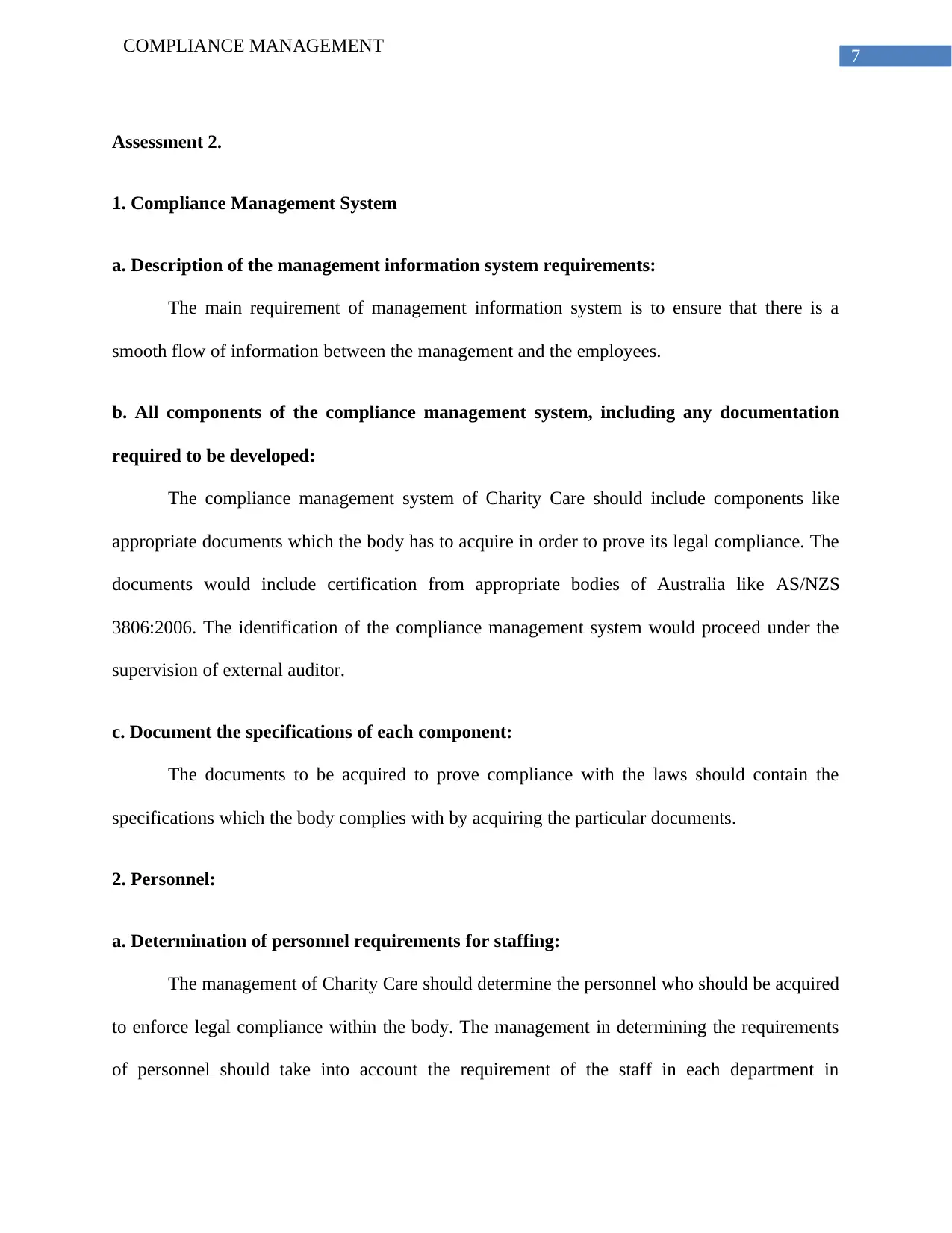
7
COMPLIANCE MANAGEMENT
Assessment 2.
1. Compliance Management System
a. Description of the management information system requirements:
The main requirement of management information system is to ensure that there is a
smooth flow of information between the management and the employees.
b. All components of the compliance management system, including any documentation
required to be developed:
The compliance management system of Charity Care should include components like
appropriate documents which the body has to acquire in order to prove its legal compliance. The
documents would include certification from appropriate bodies of Australia like AS/NZS
3806:2006. The identification of the compliance management system would proceed under the
supervision of external auditor.
c. Document the specifications of each component:
The documents to be acquired to prove compliance with the laws should contain the
specifications which the body complies with by acquiring the particular documents.
2. Personnel:
a. Determination of personnel requirements for staffing:
The management of Charity Care should determine the personnel who should be acquired
to enforce legal compliance within the body. The management in determining the requirements
of personnel should take into account the requirement of the staff in each department in
COMPLIANCE MANAGEMENT
Assessment 2.
1. Compliance Management System
a. Description of the management information system requirements:
The main requirement of management information system is to ensure that there is a
smooth flow of information between the management and the employees.
b. All components of the compliance management system, including any documentation
required to be developed:
The compliance management system of Charity Care should include components like
appropriate documents which the body has to acquire in order to prove its legal compliance. The
documents would include certification from appropriate bodies of Australia like AS/NZS
3806:2006. The identification of the compliance management system would proceed under the
supervision of external auditor.
c. Document the specifications of each component:
The documents to be acquired to prove compliance with the laws should contain the
specifications which the body complies with by acquiring the particular documents.
2. Personnel:
a. Determination of personnel requirements for staffing:
The management of Charity Care should determine the personnel who should be acquired
to enforce legal compliance within the body. The management in determining the requirements
of personnel should take into account the requirement of the staff in each department in

8
COMPLIANCE MANAGEMENT
consultation with the respective departmental heads. The human resource manager should
coordinate with the departmental heads and the management to identify the requirements of the
staff required in Charity Care.
b. Selection of suitable personnel requirements for staffing:
The suitable personnel requirements for staffing at Charity Care should include
appropriate qualifications and work experiences. The personnel which the body would staff to
enhance legal compliance should hold legal degrees. The staff should also have the experience of
working with renowned NPOs.
c. Assigning key responsibilities for each position:
The management of Charity Care post acquisition of the legal experts should assign them
with responsibilities. The departmental heads should coordinate with the apex management in
recognising the job responsibilities of the legal staff working in their respective departments.
3. Training:
a. The training requirements for implementation of proposed compliance management
system:
The employees of Charity Care should be trained to comply with the laws and
regulations. The training of employees to implement with proposed compliance management
system would require allocation of funds by the apex management. The resources required for
the training would be training room, trainer(s) and training materials. The training of employees
would also require allocation of teleconferencing systems, internet and telecommunication
systems.
COMPLIANCE MANAGEMENT
consultation with the respective departmental heads. The human resource manager should
coordinate with the departmental heads and the management to identify the requirements of the
staff required in Charity Care.
b. Selection of suitable personnel requirements for staffing:
The suitable personnel requirements for staffing at Charity Care should include
appropriate qualifications and work experiences. The personnel which the body would staff to
enhance legal compliance should hold legal degrees. The staff should also have the experience of
working with renowned NPOs.
c. Assigning key responsibilities for each position:
The management of Charity Care post acquisition of the legal experts should assign them
with responsibilities. The departmental heads should coordinate with the apex management in
recognising the job responsibilities of the legal staff working in their respective departments.
3. Training:
a. The training requirements for implementation of proposed compliance management
system:
The employees of Charity Care should be trained to comply with the laws and
regulations. The training of employees to implement with proposed compliance management
system would require allocation of funds by the apex management. The resources required for
the training would be training room, trainer(s) and training materials. The training of employees
would also require allocation of teleconferencing systems, internet and telecommunication
systems.
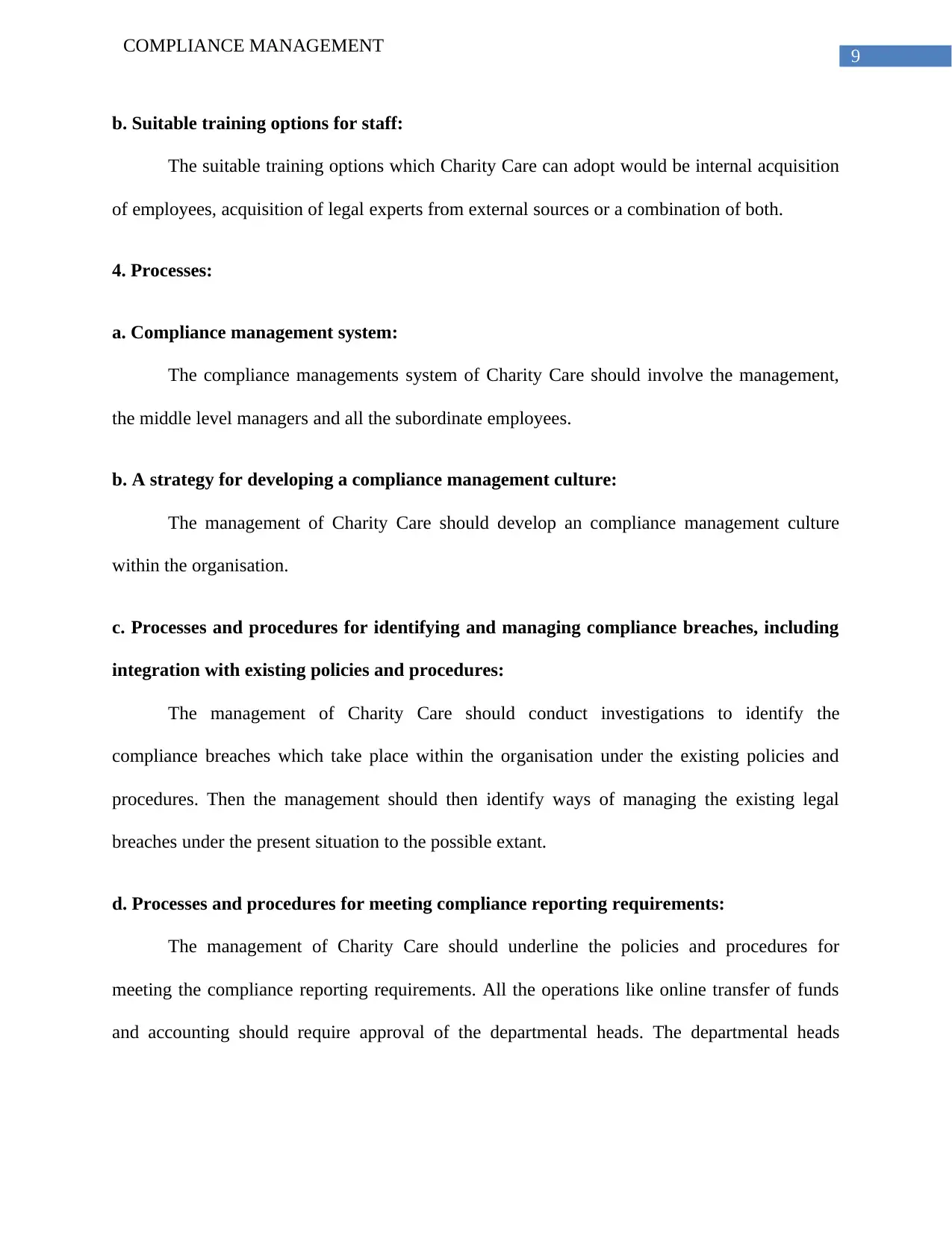
9
COMPLIANCE MANAGEMENT
b. Suitable training options for staff:
The suitable training options which Charity Care can adopt would be internal acquisition
of employees, acquisition of legal experts from external sources or a combination of both.
4. Processes:
a. Compliance management system:
The compliance managements system of Charity Care should involve the management,
the middle level managers and all the subordinate employees.
b. A strategy for developing a compliance management culture:
The management of Charity Care should develop an compliance management culture
within the organisation.
c. Processes and procedures for identifying and managing compliance breaches, including
integration with existing policies and procedures:
The management of Charity Care should conduct investigations to identify the
compliance breaches which take place within the organisation under the existing policies and
procedures. Then the management should then identify ways of managing the existing legal
breaches under the present situation to the possible extant.
d. Processes and procedures for meeting compliance reporting requirements:
The management of Charity Care should underline the policies and procedures for
meeting the compliance reporting requirements. All the operations like online transfer of funds
and accounting should require approval of the departmental heads. The departmental heads
COMPLIANCE MANAGEMENT
b. Suitable training options for staff:
The suitable training options which Charity Care can adopt would be internal acquisition
of employees, acquisition of legal experts from external sources or a combination of both.
4. Processes:
a. Compliance management system:
The compliance managements system of Charity Care should involve the management,
the middle level managers and all the subordinate employees.
b. A strategy for developing a compliance management culture:
The management of Charity Care should develop an compliance management culture
within the organisation.
c. Processes and procedures for identifying and managing compliance breaches, including
integration with existing policies and procedures:
The management of Charity Care should conduct investigations to identify the
compliance breaches which take place within the organisation under the existing policies and
procedures. Then the management should then identify ways of managing the existing legal
breaches under the present situation to the possible extant.
d. Processes and procedures for meeting compliance reporting requirements:
The management of Charity Care should underline the policies and procedures for
meeting the compliance reporting requirements. All the operations like online transfer of funds
and accounting should require approval of the departmental heads. The departmental heads
Secure Best Marks with AI Grader
Need help grading? Try our AI Grader for instant feedback on your assignments.
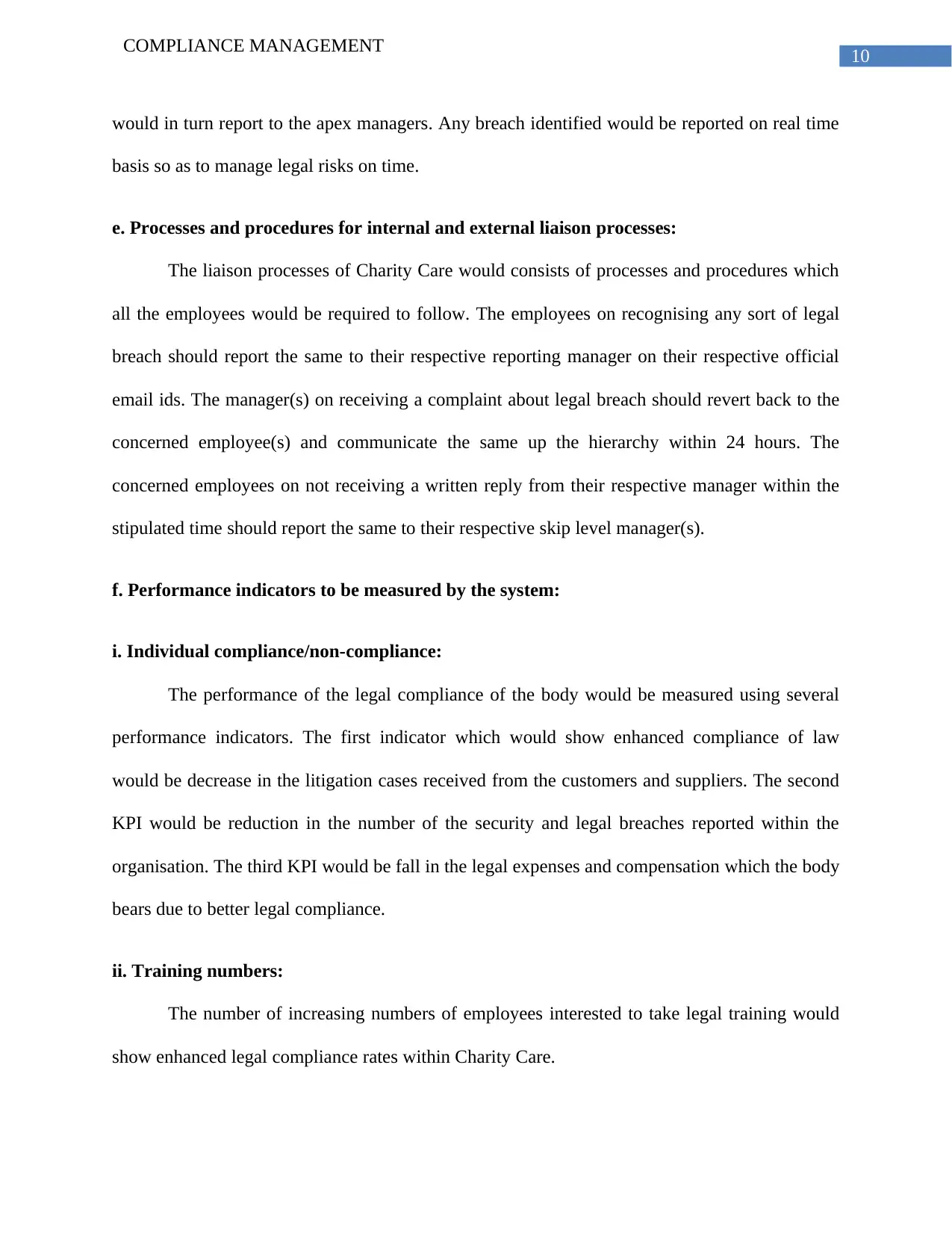
10
COMPLIANCE MANAGEMENT
would in turn report to the apex managers. Any breach identified would be reported on real time
basis so as to manage legal risks on time.
e. Processes and procedures for internal and external liaison processes:
The liaison processes of Charity Care would consists of processes and procedures which
all the employees would be required to follow. The employees on recognising any sort of legal
breach should report the same to their respective reporting manager on their respective official
email ids. The manager(s) on receiving a complaint about legal breach should revert back to the
concerned employee(s) and communicate the same up the hierarchy within 24 hours. The
concerned employees on not receiving a written reply from their respective manager within the
stipulated time should report the same to their respective skip level manager(s).
f. Performance indicators to be measured by the system:
i. Individual compliance/non-compliance:
The performance of the legal compliance of the body would be measured using several
performance indicators. The first indicator which would show enhanced compliance of law
would be decrease in the litigation cases received from the customers and suppliers. The second
KPI would be reduction in the number of the security and legal breaches reported within the
organisation. The third KPI would be fall in the legal expenses and compensation which the body
bears due to better legal compliance.
ii. Training numbers:
The number of increasing numbers of employees interested to take legal training would
show enhanced legal compliance rates within Charity Care.
COMPLIANCE MANAGEMENT
would in turn report to the apex managers. Any breach identified would be reported on real time
basis so as to manage legal risks on time.
e. Processes and procedures for internal and external liaison processes:
The liaison processes of Charity Care would consists of processes and procedures which
all the employees would be required to follow. The employees on recognising any sort of legal
breach should report the same to their respective reporting manager on their respective official
email ids. The manager(s) on receiving a complaint about legal breach should revert back to the
concerned employee(s) and communicate the same up the hierarchy within 24 hours. The
concerned employees on not receiving a written reply from their respective manager within the
stipulated time should report the same to their respective skip level manager(s).
f. Performance indicators to be measured by the system:
i. Individual compliance/non-compliance:
The performance of the legal compliance of the body would be measured using several
performance indicators. The first indicator which would show enhanced compliance of law
would be decrease in the litigation cases received from the customers and suppliers. The second
KPI would be reduction in the number of the security and legal breaches reported within the
organisation. The third KPI would be fall in the legal expenses and compensation which the body
bears due to better legal compliance.
ii. Training numbers:
The number of increasing numbers of employees interested to take legal training would
show enhanced legal compliance rates within Charity Care.
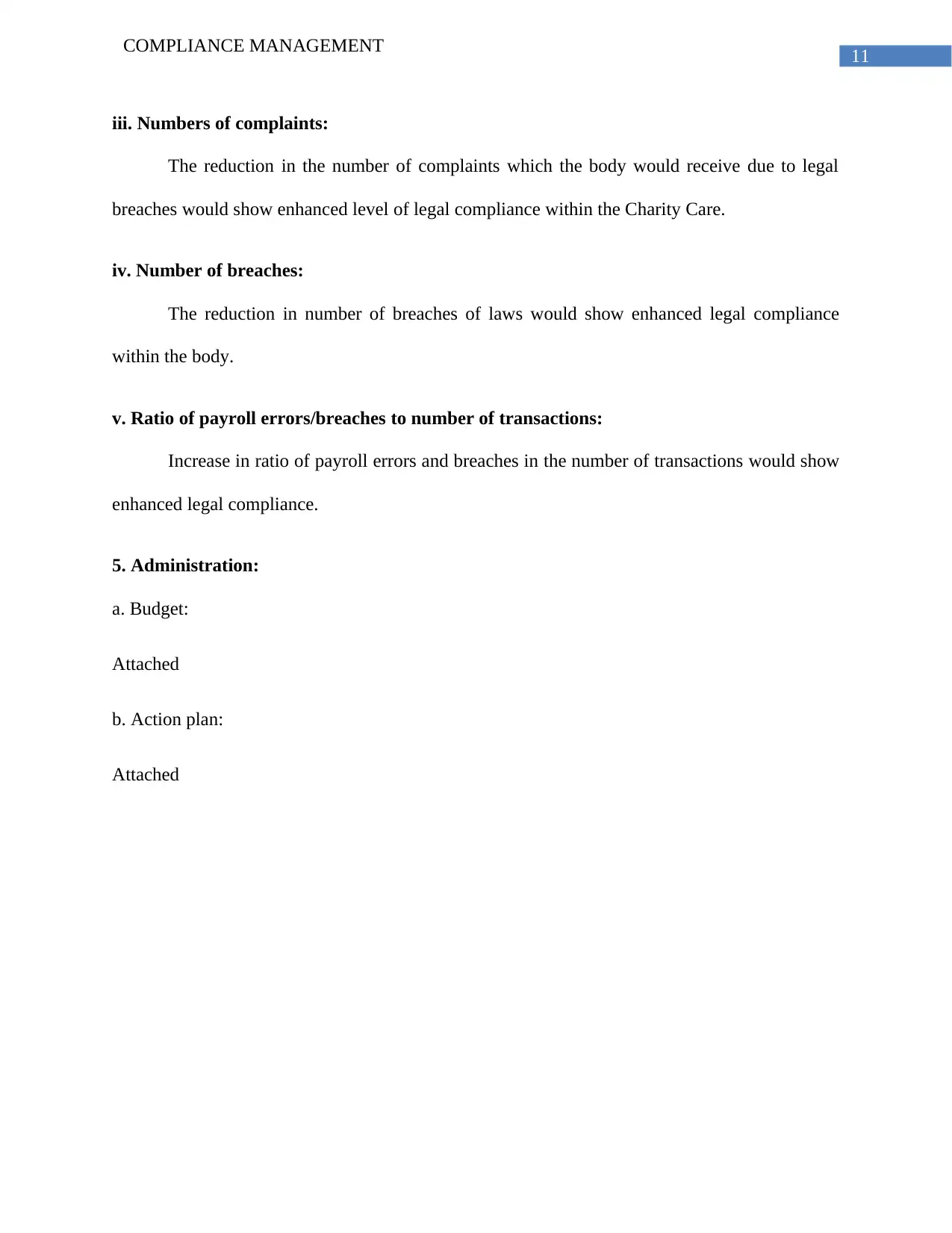
11
COMPLIANCE MANAGEMENT
iii. Numbers of complaints:
The reduction in the number of complaints which the body would receive due to legal
breaches would show enhanced level of legal compliance within the Charity Care.
iv. Number of breaches:
The reduction in number of breaches of laws would show enhanced legal compliance
within the body.
v. Ratio of payroll errors/breaches to number of transactions:
Increase in ratio of payroll errors and breaches in the number of transactions would show
enhanced legal compliance.
5. Administration:
a. Budget:
Attached
b. Action plan:
Attached
COMPLIANCE MANAGEMENT
iii. Numbers of complaints:
The reduction in the number of complaints which the body would receive due to legal
breaches would show enhanced level of legal compliance within the Charity Care.
iv. Number of breaches:
The reduction in number of breaches of laws would show enhanced legal compliance
within the body.
v. Ratio of payroll errors/breaches to number of transactions:
Increase in ratio of payroll errors and breaches in the number of transactions would show
enhanced legal compliance.
5. Administration:
a. Budget:
Attached
b. Action plan:
Attached
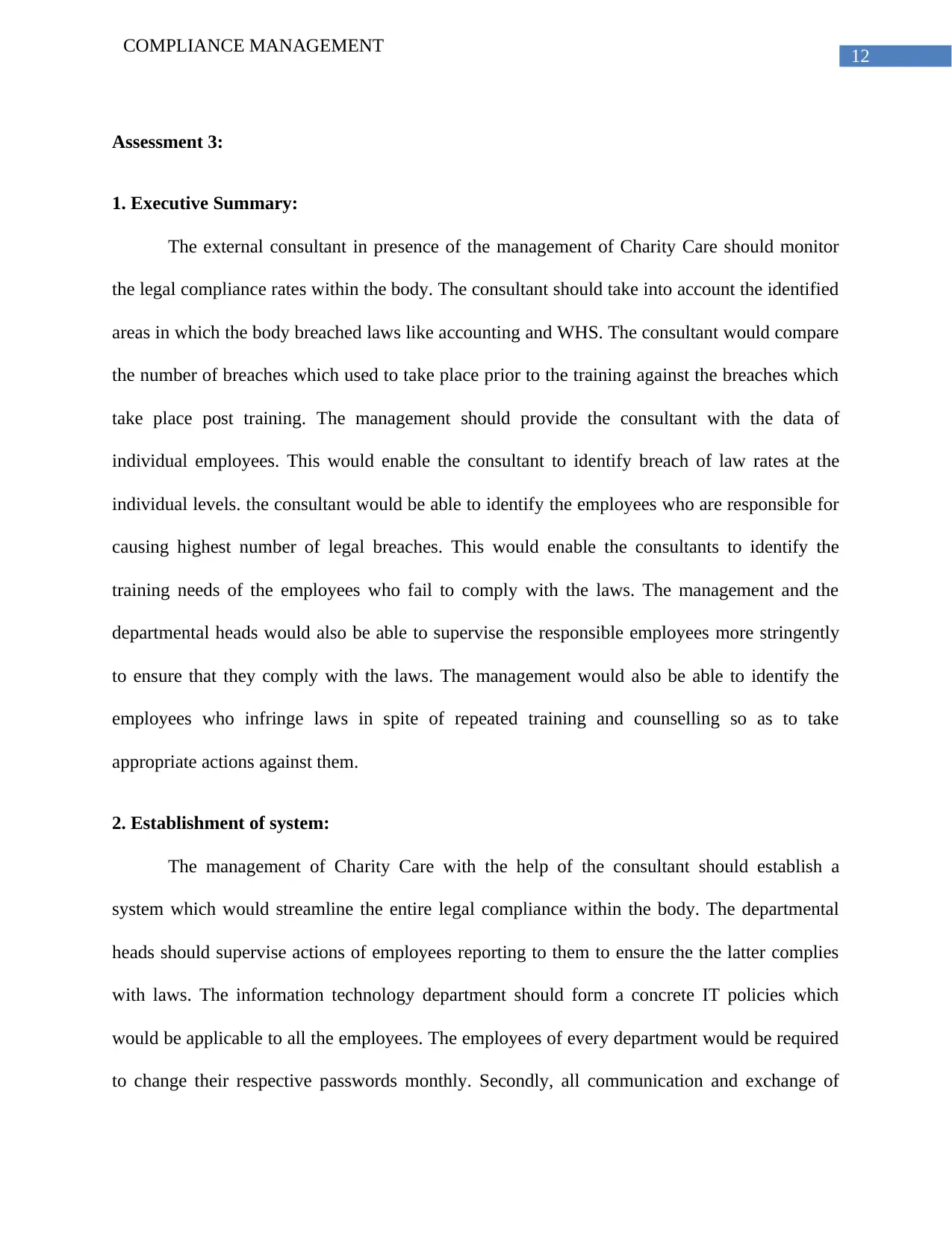
12
COMPLIANCE MANAGEMENT
Assessment 3:
1. Executive Summary:
The external consultant in presence of the management of Charity Care should monitor
the legal compliance rates within the body. The consultant should take into account the identified
areas in which the body breached laws like accounting and WHS. The consultant would compare
the number of breaches which used to take place prior to the training against the breaches which
take place post training. The management should provide the consultant with the data of
individual employees. This would enable the consultant to identify breach of law rates at the
individual levels. the consultant would be able to identify the employees who are responsible for
causing highest number of legal breaches. This would enable the consultants to identify the
training needs of the employees who fail to comply with the laws. The management and the
departmental heads would also be able to supervise the responsible employees more stringently
to ensure that they comply with the laws. The management would also be able to identify the
employees who infringe laws in spite of repeated training and counselling so as to take
appropriate actions against them.
2. Establishment of system:
The management of Charity Care with the help of the consultant should establish a
system which would streamline the entire legal compliance within the body. The departmental
heads should supervise actions of employees reporting to them to ensure the the latter complies
with laws. The information technology department should form a concrete IT policies which
would be applicable to all the employees. The employees of every department would be required
to change their respective passwords monthly. Secondly, all communication and exchange of
COMPLIANCE MANAGEMENT
Assessment 3:
1. Executive Summary:
The external consultant in presence of the management of Charity Care should monitor
the legal compliance rates within the body. The consultant should take into account the identified
areas in which the body breached laws like accounting and WHS. The consultant would compare
the number of breaches which used to take place prior to the training against the breaches which
take place post training. The management should provide the consultant with the data of
individual employees. This would enable the consultant to identify breach of law rates at the
individual levels. the consultant would be able to identify the employees who are responsible for
causing highest number of legal breaches. This would enable the consultants to identify the
training needs of the employees who fail to comply with the laws. The management and the
departmental heads would also be able to supervise the responsible employees more stringently
to ensure that they comply with the laws. The management would also be able to identify the
employees who infringe laws in spite of repeated training and counselling so as to take
appropriate actions against them.
2. Establishment of system:
The management of Charity Care with the help of the consultant should establish a
system which would streamline the entire legal compliance within the body. The departmental
heads should supervise actions of employees reporting to them to ensure the the latter complies
with laws. The information technology department should form a concrete IT policies which
would be applicable to all the employees. The employees of every department would be required
to change their respective passwords monthly. Secondly, all communication and exchange of
Paraphrase This Document
Need a fresh take? Get an instant paraphrase of this document with our AI Paraphraser

13
COMPLIANCE MANAGEMENT
documents should take place via official email ids of employees. Fourthly, in order to get access
to customer data, the employees would have to acquire approval of their respective departmental
heads. Fourthly, legal compliance should be implemented with the organisational culture of
Charity Care. Any employee infringing laws should be dealt with strictly irrespective of
departments and designations. The employees complying with laws would be awarded in order
to encourage other employees to comply with the laws.
3. Monitoring methodology:
The apex management body of Charity Care should adopt monitoring methodology. The
monitoring methodology should enable the management to monitor legal compliance within the
body. As mentioned above adopting strict supervision on all the employees would enable the
management to confirm legal compliance. The management of Charity Care should empower all
the employees to ensure legal compliance among both their peers, managers and subordinates.
The management on identifying employees breaching laws should supervise the employees
concerned on daily basis. The departmental heads of the employees concerned should vigil all
the operations and actions done by the employee concerned which would involve use of the
capital of the NPO. The capital over here refers to information systems, customer data, software
or any other asset in possession of the body. The employees under vigilance would have no
direct access to the information systems of the body. They can only accede to the information
only on acquisition of the approval of their respective reporting managers. This strict vigilance
on employees proven to infringe laws would enable the body to monitor the legal compliance.
4. Results and analysis:
The analysis of the above discussion show that it is very important to monitor the actions
of the employees to ensure proper compliance with laws. This is because infringement of laws by
COMPLIANCE MANAGEMENT
documents should take place via official email ids of employees. Fourthly, in order to get access
to customer data, the employees would have to acquire approval of their respective departmental
heads. Fourthly, legal compliance should be implemented with the organisational culture of
Charity Care. Any employee infringing laws should be dealt with strictly irrespective of
departments and designations. The employees complying with laws would be awarded in order
to encourage other employees to comply with the laws.
3. Monitoring methodology:
The apex management body of Charity Care should adopt monitoring methodology. The
monitoring methodology should enable the management to monitor legal compliance within the
body. As mentioned above adopting strict supervision on all the employees would enable the
management to confirm legal compliance. The management of Charity Care should empower all
the employees to ensure legal compliance among both their peers, managers and subordinates.
The management on identifying employees breaching laws should supervise the employees
concerned on daily basis. The departmental heads of the employees concerned should vigil all
the operations and actions done by the employee concerned which would involve use of the
capital of the NPO. The capital over here refers to information systems, customer data, software
or any other asset in possession of the body. The employees under vigilance would have no
direct access to the information systems of the body. They can only accede to the information
only on acquisition of the approval of their respective reporting managers. This strict vigilance
on employees proven to infringe laws would enable the body to monitor the legal compliance.
4. Results and analysis:
The analysis of the above discussion show that it is very important to monitor the actions
of the employees to ensure proper compliance with laws. This is because infringement of laws by
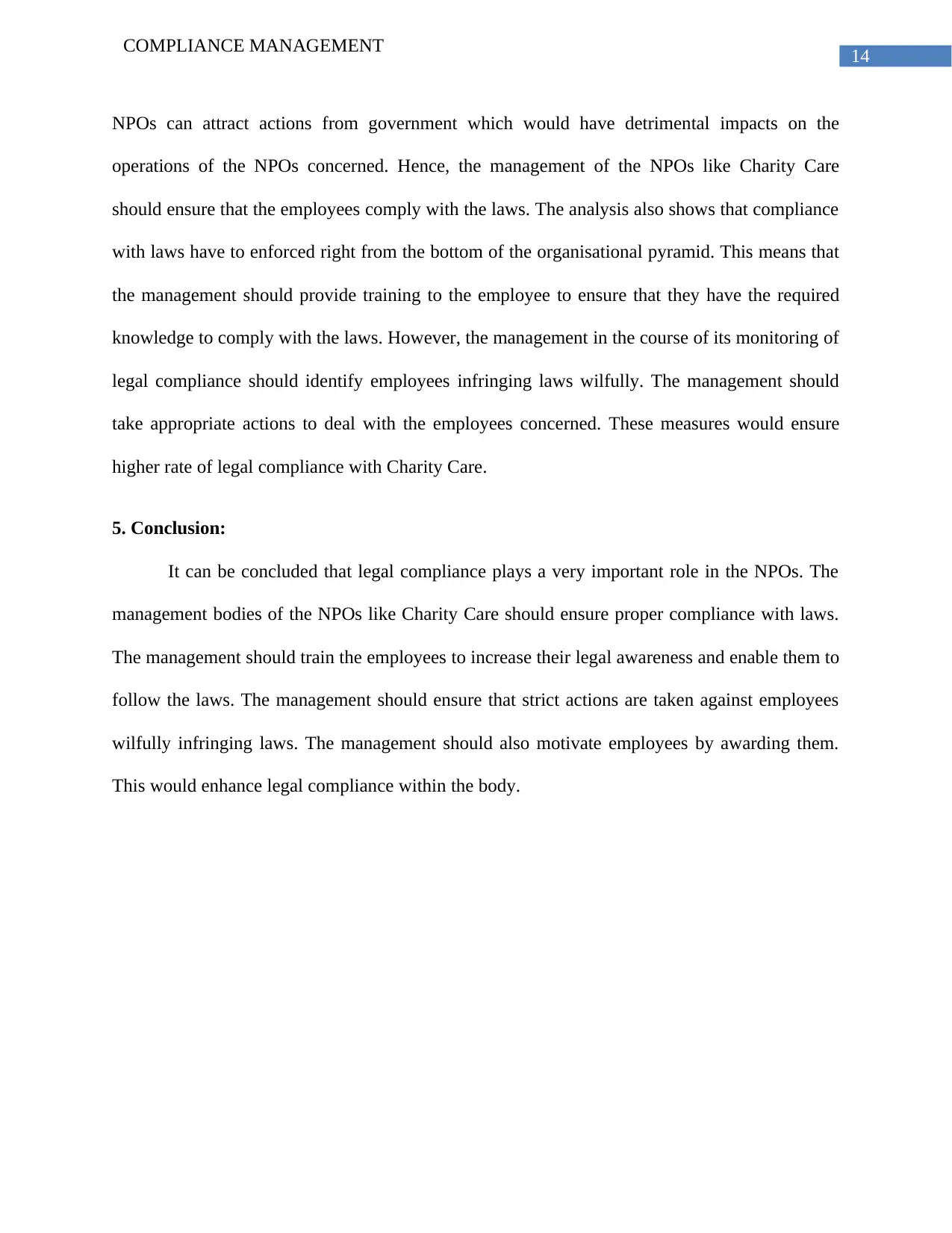
14
COMPLIANCE MANAGEMENT
NPOs can attract actions from government which would have detrimental impacts on the
operations of the NPOs concerned. Hence, the management of the NPOs like Charity Care
should ensure that the employees comply with the laws. The analysis also shows that compliance
with laws have to enforced right from the bottom of the organisational pyramid. This means that
the management should provide training to the employee to ensure that they have the required
knowledge to comply with the laws. However, the management in the course of its monitoring of
legal compliance should identify employees infringing laws wilfully. The management should
take appropriate actions to deal with the employees concerned. These measures would ensure
higher rate of legal compliance with Charity Care.
5. Conclusion:
It can be concluded that legal compliance plays a very important role in the NPOs. The
management bodies of the NPOs like Charity Care should ensure proper compliance with laws.
The management should train the employees to increase their legal awareness and enable them to
follow the laws. The management should ensure that strict actions are taken against employees
wilfully infringing laws. The management should also motivate employees by awarding them.
This would enhance legal compliance within the body.
COMPLIANCE MANAGEMENT
NPOs can attract actions from government which would have detrimental impacts on the
operations of the NPOs concerned. Hence, the management of the NPOs like Charity Care
should ensure that the employees comply with the laws. The analysis also shows that compliance
with laws have to enforced right from the bottom of the organisational pyramid. This means that
the management should provide training to the employee to ensure that they have the required
knowledge to comply with the laws. However, the management in the course of its monitoring of
legal compliance should identify employees infringing laws wilfully. The management should
take appropriate actions to deal with the employees concerned. These measures would ensure
higher rate of legal compliance with Charity Care.
5. Conclusion:
It can be concluded that legal compliance plays a very important role in the NPOs. The
management bodies of the NPOs like Charity Care should ensure proper compliance with laws.
The management should train the employees to increase their legal awareness and enable them to
follow the laws. The management should ensure that strict actions are taken against employees
wilfully infringing laws. The management should also motivate employees by awarding them.
This would enhance legal compliance within the body.
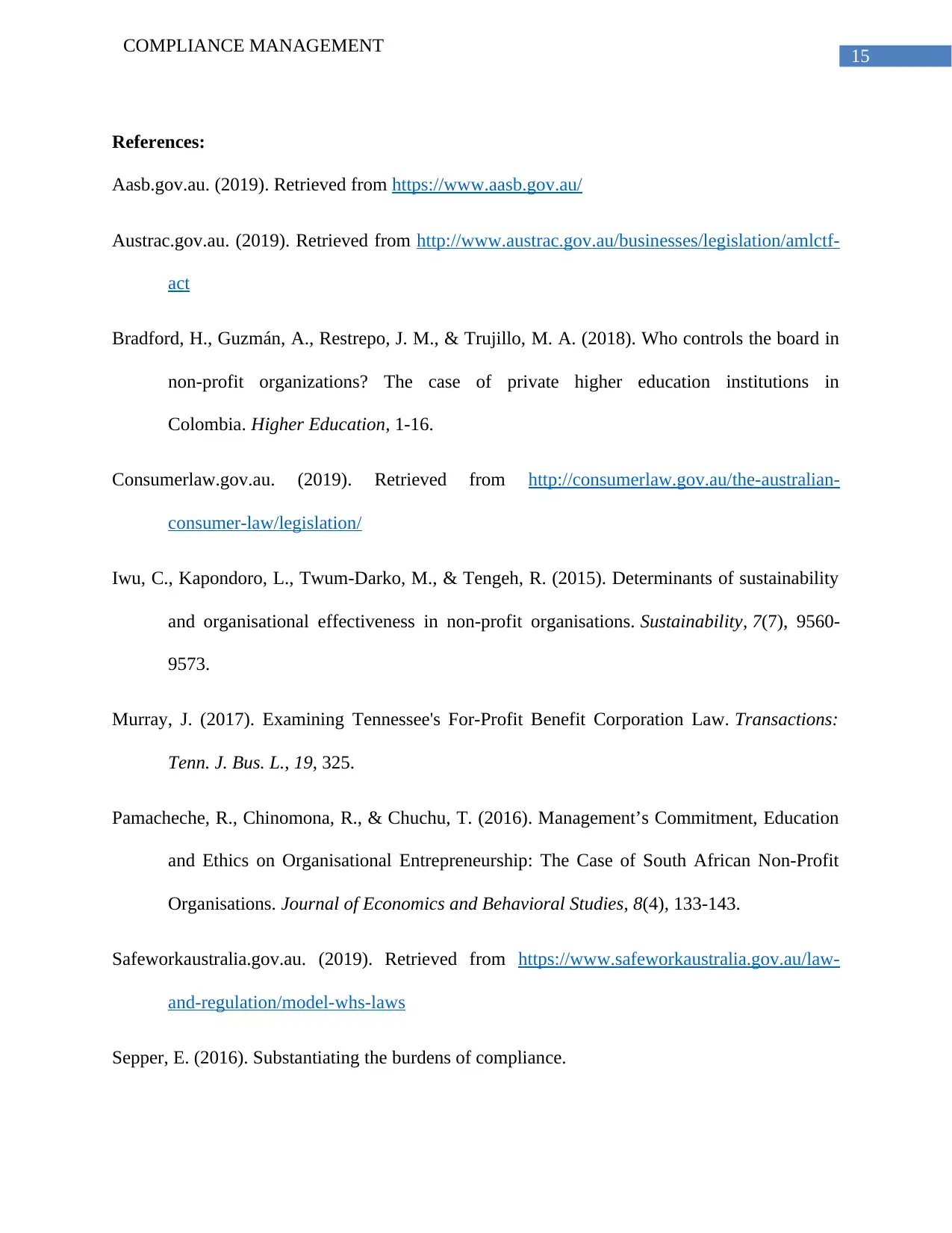
15
COMPLIANCE MANAGEMENT
References:
Aasb.gov.au. (2019). Retrieved from https://www.aasb.gov.au/
Austrac.gov.au. (2019). Retrieved from http://www.austrac.gov.au/businesses/legislation/amlctf-
act
Bradford, H., Guzmán, A., Restrepo, J. M., & Trujillo, M. A. (2018). Who controls the board in
non-profit organizations? The case of private higher education institutions in
Colombia. Higher Education, 1-16.
Consumerlaw.gov.au. (2019). Retrieved from http://consumerlaw.gov.au/the-australian-
consumer-law/legislation/
Iwu, C., Kapondoro, L., Twum-Darko, M., & Tengeh, R. (2015). Determinants of sustainability
and organisational effectiveness in non-profit organisations. Sustainability, 7(7), 9560-
9573.
Murray, J. (2017). Examining Tennessee's For-Profit Benefit Corporation Law. Transactions:
Tenn. J. Bus. L., 19, 325.
Pamacheche, R., Chinomona, R., & Chuchu, T. (2016). Management’s Commitment, Education
and Ethics on Organisational Entrepreneurship: The Case of South African Non-Profit
Organisations. Journal of Economics and Behavioral Studies, 8(4), 133-143.
Safeworkaustralia.gov.au. (2019). Retrieved from https://www.safeworkaustralia.gov.au/law-
and-regulation/model-whs-laws
Sepper, E. (2016). Substantiating the burdens of compliance.
COMPLIANCE MANAGEMENT
References:
Aasb.gov.au. (2019). Retrieved from https://www.aasb.gov.au/
Austrac.gov.au. (2019). Retrieved from http://www.austrac.gov.au/businesses/legislation/amlctf-
act
Bradford, H., Guzmán, A., Restrepo, J. M., & Trujillo, M. A. (2018). Who controls the board in
non-profit organizations? The case of private higher education institutions in
Colombia. Higher Education, 1-16.
Consumerlaw.gov.au. (2019). Retrieved from http://consumerlaw.gov.au/the-australian-
consumer-law/legislation/
Iwu, C., Kapondoro, L., Twum-Darko, M., & Tengeh, R. (2015). Determinants of sustainability
and organisational effectiveness in non-profit organisations. Sustainability, 7(7), 9560-
9573.
Murray, J. (2017). Examining Tennessee's For-Profit Benefit Corporation Law. Transactions:
Tenn. J. Bus. L., 19, 325.
Pamacheche, R., Chinomona, R., & Chuchu, T. (2016). Management’s Commitment, Education
and Ethics on Organisational Entrepreneurship: The Case of South African Non-Profit
Organisations. Journal of Economics and Behavioral Studies, 8(4), 133-143.
Safeworkaustralia.gov.au. (2019). Retrieved from https://www.safeworkaustralia.gov.au/law-
and-regulation/model-whs-laws
Sepper, E. (2016). Substantiating the burdens of compliance.
Secure Best Marks with AI Grader
Need help grading? Try our AI Grader for instant feedback on your assignments.
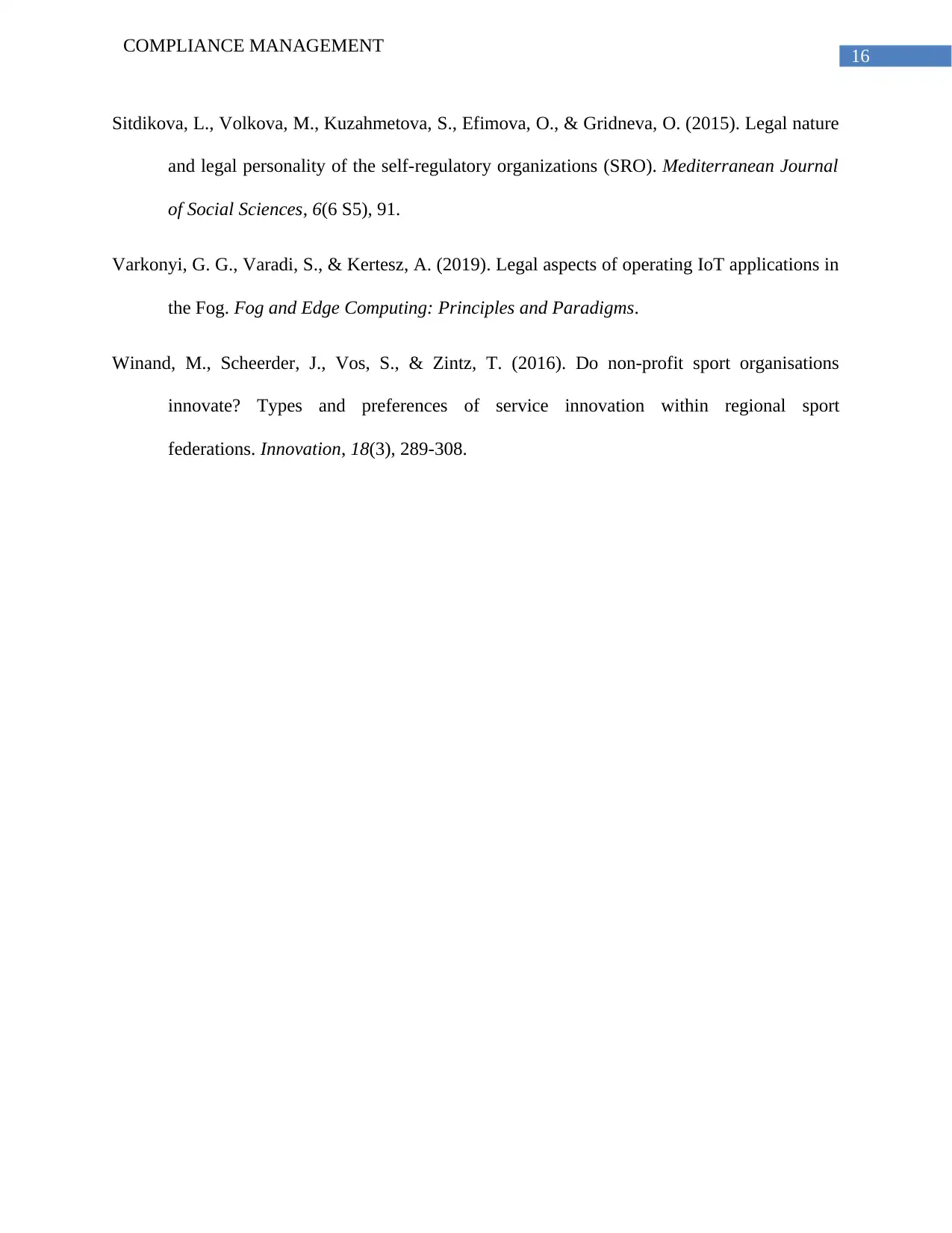
16
COMPLIANCE MANAGEMENT
Sitdikova, L., Volkova, M., Kuzahmetova, S., Efimova, O., & Gridneva, O. (2015). Legal nature
and legal personality of the self-regulatory organizations (SRO). Mediterranean Journal
of Social Sciences, 6(6 S5), 91.
Varkonyi, G. G., Varadi, S., & Kertesz, A. (2019). Legal aspects of operating IoT applications in
the Fog. Fog and Edge Computing: Principles and Paradigms.
Winand, M., Scheerder, J., Vos, S., & Zintz, T. (2016). Do non-profit sport organisations
innovate? Types and preferences of service innovation within regional sport
federations. Innovation, 18(3), 289-308.
COMPLIANCE MANAGEMENT
Sitdikova, L., Volkova, M., Kuzahmetova, S., Efimova, O., & Gridneva, O. (2015). Legal nature
and legal personality of the self-regulatory organizations (SRO). Mediterranean Journal
of Social Sciences, 6(6 S5), 91.
Varkonyi, G. G., Varadi, S., & Kertesz, A. (2019). Legal aspects of operating IoT applications in
the Fog. Fog and Edge Computing: Principles and Paradigms.
Winand, M., Scheerder, J., Vos, S., & Zintz, T. (2016). Do non-profit sport organisations
innovate? Types and preferences of service innovation within regional sport
federations. Innovation, 18(3), 289-308.
1 out of 17
Your All-in-One AI-Powered Toolkit for Academic Success.
+13062052269
info@desklib.com
Available 24*7 on WhatsApp / Email
![[object Object]](/_next/static/media/star-bottom.7253800d.svg)
Unlock your academic potential
© 2024 | Zucol Services PVT LTD | All rights reserved.